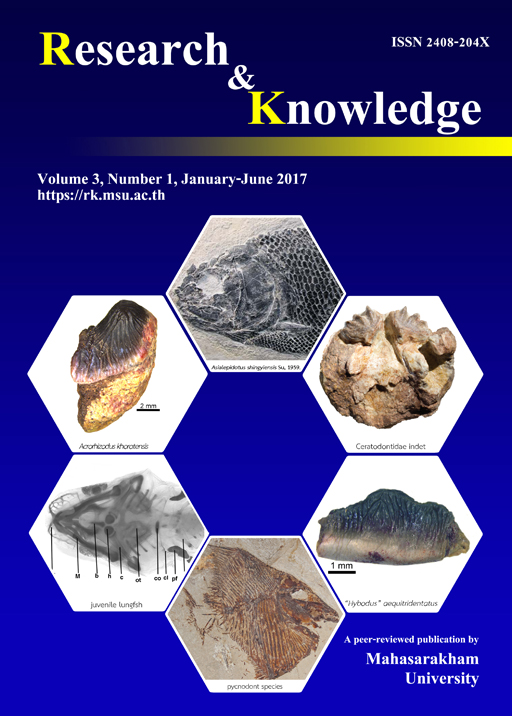150 million years of freshwater fish biogeography: vicariance or dispersal?
Keywords:
Actinopterygii, Sarcopterygii, Mesozoic, Cenozoic, PangaeaAbstract
Freshwater fishes are supposedly good case studies to test palaeobiogeographical models because they are attached to land masses, at least primary freshwater fishes, which are unable to cross marine barriers. In this study, I review the literature about the fossil record and about the phylogeny of various freshwater fish groups in order to address, in a qualitative way, the biogeographic scenarios proposed to explain their modern distribution. At the intercontinental scale, vicariant events seem to have played a minor role in the distribution of main freshwater fish clades, except for some during the first phases of the break-up. Most of the biogeographical events that shaped the modern distribution of freshwater fish clades are likely dispersals events that occurred in the Late Cretaceous and in the Palaeogene.
References
Böhme, M. 2004. Migration history of air-breathing fishes reveals Neogene atmospheric circulation patterns. Geology 32, 393-396.
Cavin, L. 2017. Freshwater Fishes - 250 Million Years of Evolutionary History. ISTE Press - Elsevier, 214 pp.
Chen, W. -J., Lavoué, S. and Mayden, R. L. 2013. Evolutionary origin and early biogeography of otophysan fishes (Ostariophysi: Teleostei). Evolution 67, 2218- 2239.
Friedman, M., Keck, B. P., Dornburg, A., Eytan, R. I., Martin, C. H., Hulsey, C. D., Wainwright, P. C. and Near, T. J. 2013. Molecular and fossil evidence place the origin of cichlid fishes long after Gondwanan rifting. Proceedings of the Royal Society B 280, 1-8.
Gaudant, J. 2014. Characiform fishes (Teleosts, Ostariophysi): how many waves of immigration into Europe during the Cenozoic? Neues Jahrbuch für Geologie und Paläontologie - Abhandlungen 273, 319-326.
Hirt, M. V., Arratia, G., Chen, W. -J., Mayden, R. L., Tang, K. L., Wood, R. M. and Simons, A. M. 2017. Effects of gene choice, base composition and rate heterogeneity on inference and estimates of divergence times in cypriniform fishes. Biological Journal of the Linnean Society 121, 319-339.
Kappas, I., Vittas, S., Pantzartzi, C. N., Drosopoulou, E. and Scouras, Z. G. 2016. A Time-Calibrated Mitogenome Phylogeny of Catfish (Teleostei: Siluriformes). PloSOne 11(12), e0166988.
Lavoué, S. 2016. Was Gondwanan breakup the cause of the intercontinental distribution of Osteoglossiformes? A time-calibrated phylogenetic test combining molecular, morphological, and paleontological evidence. Molecular Phylogenetics and Evolution 99, 34-43.
Murray, A. M. 2001. The fossil record and biogeography of the Cichlidae (Actinopterygii: Labroidei). Biological Journal of the Linnean Society 74, 517-532.
Newbrey, M., Murray, A., Wilson, M., Brinkman, D. and Neuman, A. 2009. Seventy-five-million-year-old tropical tetra-like fish from Canada tracks Cretaceous global warming. Proceedings of the Royal Society of London B: Biological Sciences 276 (1674), 3829- 3833.
Otero, O., Valetin, X. and Garcia, G. 2008. Cretaceous characiform fishes (Teleostei: Ostariophysi) from Northern Tethys: description of new material from the Maastrichtian of Provence (Southern France) and palaeobiogeographical implications. In: Cavin, L., Longbottom, A. and Richter, M. (Eds.), Fishes and the Break-up of Pangaea. Geological Society, London 295, pp. 155-164.
Saitoh, K., Sado, T., Doosey, M. H., Bart, H. L., Inoue, J. G., Nishida, M., Mayden, R. L., Nishida, M. and Miya, M. 2011. Evidence from mitochondrial genomics supports the lower Mesozoic of South Asia as the time and place of basal divergence of cypriniform fishes (Actinopterygii: Ostariophysi). Zoological Journal of the Linnean Society 161, 633-662.
Schaeffer, B. 1952. The evidence of the fresh-water fishes. Bulletin of the American Museum of Natural History 99, 227-234.
Sparks, J. S. and Smith, W. L. 2005. Freshwater fishes, dispersal ability, and nonevidence:“Gondwana life rafts” to the rescue. Systematic Biology 54, 158-165.
Sullivan, J. P., Lundberg, J. G. and Hardman, M. 2006. A phylogenetic analysis of the major groups of catfishes (Teleostei: Siluriformes) using rag1 and rag2 nuclear gene sequences. Molecular phylogenetics and evolution 41, 636-662.
Waddell, L. M. and Moore, T. C. 2008. Salinity of the Eocene Arctic Ocean from oxygen isotope analysis of fish bone carbonate. Paleoceanography 23, 1-14.
Zhang, J., 2006. Phylogeny of osteoglossomorpha. Vertebrata PalAsiatica 44, 43-59.
Downloads
Published
How to Cite
Issue
Section
License

This work is licensed under a Creative Commons Attribution-NoDerivatives 4.0 International License.








